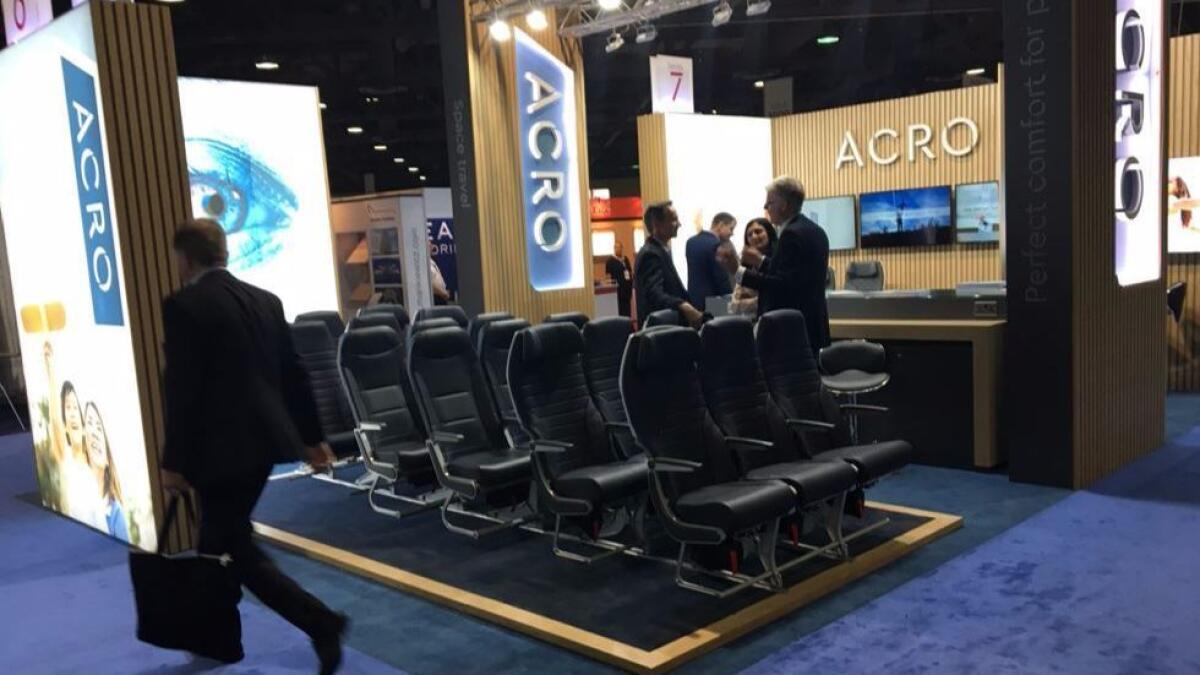Airline seats are not getting bigger, but designers are trying to make them more comfortable

Marc Westcott stands a beefy 6 feet 3, and he figures that might just be the best marketing tool he’s got.
Westcott is an account manager for Acro Aircraft Seating, a British company that makes seats for Frontier, Spirit and other airlines — a booming but tricky business these days.
Airlines are notoriously packing more and more passengers into their planes by squeezing them into smaller seats. That’s boosted profits, but passengers are cramped and unhappy.
At last week’s Aircraft Interiors Expo in Long Beach, Westcott attempted to show it doesn’t have to be that way. He slid his hefty frame into his company’s latest economy seat, part of a working display laid out in a half-dozen rows.
“Look, my knees have plenty of room,” he pointed out.
It wasn’t a magic trick. The feat was accomplished because the backrest of the seat in front curved away from his knees. To make that possible, the seat’s backrest is fitted with thinner padding.
New padding, body-shaped seat designs, carbon-fiber frames and other tweaks were all on display at the biannual convention, where even a former designer of Formula One race-car seats was showing off his wares.
Manufacturers have good reason to come up with new ideas. The manufacturing of airline seats and other aircraft interiors is a $17-billion industry that is expected to grow to $29 billion by 2021 as travel demand continues to surge.
Aircraft maker Boeing predicts the airline industry will need 37,200 new single-aisle and wide-body jets over the next 20 years. Airline-seat contracts are lucrative. A Middle Eastern airline recently agreed to pay $41 million to install economy seats on 39 planes.
The airline industry began to squeeze passenger space shortly after jet fuel costs began to spike, starting in 2011, to make room for extra seats and help boost profits.
Since then, the average seat pitch — the distance between the back of one seat and the back of the next — has dropped from 35 inches to 31 inches, according to a passenger rights group that has petitioned the federal government to halt the trend. Ultra low-cost carriers, like Acro’s customer Spirit, have reduced the pitch on many seats to 28 inches.
So, how can a seat manufacturer make less personal space more comfortable?
Tom Eaton, director of design for Lift, a Huntington Beach seat maker, says economy seats are more comfortable when the bottom of the seat and the back support are curved to conform with the shape of the body instead of being flat, like traditional seats.
Lift has a partnership with Boeing, which allows the seat manufacturer access to Boeing cabin designs. This means Lift can create a seat that fits like a jigsaw puzzle piece right up to the wall of the cabin, he said. And that can mean adding an extra inch or two to the window seats.
In addition, Lift uses three types of foam in the seat padding, with softer foam that comes in contact with the back of the knees and harder foam under the buttocks.
And like the seats made by Acro, the lower back of the Lift seat is curved away from the knees of the passenger behind you.
“Knee space is absolutely critical,” Eaton said.
To increase knee space, many seat manufactures have also moved the tray tables higher on the seat back. Plus, support beams that run horizontally underneath the seats have been eliminated or raised to give passengers more foot room.
At least one seat manufacturer displayed a design at the Long Beach expo that can recline without leaning into the passenger in back. Instead, the seat bottom slides forward, allowing the seat back to tilt.
Another manufacturer was displaying a row of economy seats that allows the seat back of the middle seat to fold down to become a food tray — for that rare occasion when the middle seat is empty.
As for the padding, San Jose-based Supracor makes cushion material that uses thermoplastic urethane pressed into a honeycomb design that is thinner and lighter than traditional seat foam, said Susan Wilson, vice president of the company.
The honeycomb padding has been used in running shoes and in the bumpers of theme park rides.
A seat that would normally need 3 inches of standard foam cushioning can be just as comfortable with only 1 inch of the honeycomb material, she said. Plus, Supracor says the padding allows air to circulate through the material to keep the passenger cooler.
Swiss International Air has agreed to use the honeycomb material in its economy seats. “We hope U.S. carriers will jump on board,” she said.
Phil Hall, a design engineer who worked on Formula One cars for nearly 20 years, launched a U.K. seat manufacturer two years ago called Mirus Aircraft Seating.
Like Formula One cars, airliners need comfortable, lightweight seats, said James Woodhead, sales and marketing manager for Mirus.
At the Long Beach expo, Mirus showed off a sleek, black airline seat made of high-strength carbon fiber. The material is so strong that the seat frame can be thinner than traditional metal frames but will still pass federal government strength tests.
“When you are dealing with pitch and width, a few extra inches makes a huge difference,” he said.
The seat also weighs less than 20 pounds, at least 6 pounds lighter than most seats in planes now, he said — a reduction that saves on fuel expenses.
Malaysian low-cost carrier AirAsia X was the first carrier to sign contracts to put Mirus seats on all of its A330 and A320 planes.
Mirus has opened offices in Los Angeles and Santiago, Chile, to lobby carriers in North and South America to buy into its race-car-inspired seats.
Industry experts say the new seats that feature advanced materials and designs are 20% to 25% more expensive to make than older seats. The challenge for seat makers is to convince airlines that the extra cost will pay off with fuel savings and happier customers.
“We are putting more and more features into these seats, that has increased the cost,” said Eaton, of Acro.
Aircraft interior designers have some flexibility on making seats because the federal government does not impose any regulations on airline seat sizes. Instead, the FAA requires only that seats be spaced far enough apart that all passengers can escape the cabin within 90 seconds with half the exits blocked. The FAA also requires that seats meet structural strength requirements.
So far, passenger surveys show that travelers are not happy with the trend of shrinking legroom and thinner cushioning.
And airline critics are not optimistic that manufacturers can make a seat with less legroom more comfortable with new padding and curved seat designs.
Paul Hudson, president of FlyersRights.org, a passenger rights group that has petitioned the Federal Aviation Administration to set minimum seat sizes, said even flight attendants oppose squeezing more passengers per plane because they fear it will only frustrate travelers more.
“The idea that the seats should be made smaller with less legroom is like throwing gasoline on fire,” he said.
To read more about the travel and tourism industries, follow @hugomartin on Twitter.







